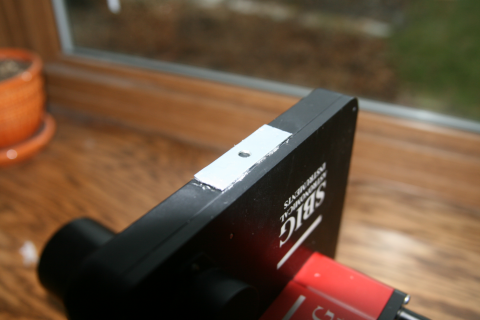Here's what the ST-8300 looks like when sporting a lens:
 |
| ST-8300 + filter wheel + 200mm lens |
 |
| ST-8300 + filter wheeel, rear view. Note the lack of any useful sighting lines. |
To get an idea of how small a 200 mm field is, take a look at this:
 |
| 200mm field of view with ST-8300 |
A finder that addresses this problem should:
- Have a large field
- Not be permanently attached to the camera; it won't be needed when imaging with longer focal length telescopes
- Not require permanent modifications to the camera or filter wheel
- Be secure regardless of the orientation of the CCD
- Not interfere with the operation of the CCD
 |
| Generic Red-Dot Finder |
It would be nice to have some sort of quick-release attachment. Because of the way my ST-8300 is mounted the filter wheel (FW) presents a clean edge on which to mount a finder:
 |
| Top edge of filter wheel |
My first thought was to use magnetic coupling but the filter wheel case is aluminum. If I could attach some steel to the FW and then use strong magnets on the stalk to hold it to the steel I'd be in business.That way after the target is composed I can remove the finder and its magnetic influence. (I don't know if a magnet can affect the FW operation, but why take a chance?)
The finder stalk glued to a bar magnet:
A small strip of steel glued to the top of the FW. It's sized to not span the seam of the FW.
For the adhesive I prefer to use something that can eventually be removed without damaging the FW's finish. Beacon 3-in-1 Advanced Craft Glue works well
| Beacon 3-in-1 Advanced Craft Glue |
This can aim in any direction and the finder stays in place.
I should mention that an earlier prototype didn't work. Instead of a steel plate I used two washers, and the magnetic hold was too weak. Also be aware that some magnets have their strongest attraction on one face. The big bar magnet I used here is overkill; smaller yet stronger rare earth magnets would be preferable, but I used what was on hand. If I encounter any slippage I'll probably replace the bar with stronger magnets.
Odd but true. In 1979 I viewed a total solar eclipse from a point north of Williston, ND. If I live to be 91 (plus 22 days) I would be able to return to the same exact spot and see another total solar eclipse. Although a point further south will have a longer duration, so I'll have some decisions to make if I live that long!



No comments:
Post a Comment